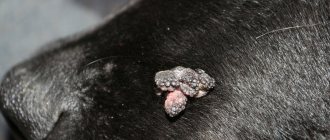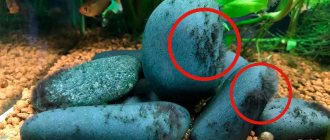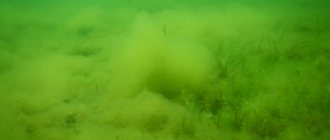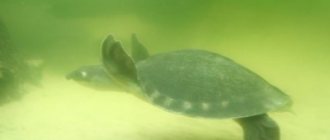Everyone who keeps an aquarium has at least once encountered white worms appearing in it. Most often these are nematodes or, simply put, roundworms that live in any environment, which can be soil and water. An experienced aquarist will immediately say that there is nothing wrong with this, while a beginner will be clearly frightened by the appearance of helminths in an aquarium with pet fish.
For a person, any worms are something unpleasant and creepy, so after discovering them, many are even afraid to put their hands in the water, not to mention fully caring for their fish.
What to do in such a situation? To get started, we recommend reading this article. This article describes in detail methods of controlling parasites. We also recommend that you consult a specialist. Read the article >>>
It is assumed that parasites appear only in advanced cases, when a person does not care about the container and contents. But this is not true, because nematodes in an aquarium can develop at a rapid pace, regardless of what conditions the aquarist has created.
Today, this roundworm is the most common type of helminth and affects humans, animals and plants. Some subspecies of nematodes reach enormous sizes, up to almost 8 meters in length. There are about 20 thousand varieties of this worm, all of them live not only in humans or animals and can be found in fish, crustaceans, wild animals, as well as in plants, such as mushrooms or cereals.
As medical studies have shown, the largest roundworms were seen in whales and reached several meters in length, but most often, nematodes are small parasites a few millimeters long.
If you notice white worms on the walls of your aquarium, do not be alarmed; of course, it is an unpleasant feeling that, in addition to fish, you have some kind of parasites in your aquarium, but you can get rid of them.
The most common helminths that appear in the aquarium
Let's first understand what a parasite is. There are three types of worms that most often settle in an aquarium:
Nematodes
Nematodes are also called microworms, they are indeed the most common throughout the world and are multicellular organisms. Most often they swim freely throughout the aquarium, both independently and thanks to a stream of water from the aquarium filter.
Many people are interested in the question of whether nematodes are dangerous in an aquarium and whether it is possible to destroy the helminth without harming the fish? In fact, you can get rid of them in a short time, while the helminths themselves do not affect the inhabitants of the aquarium in any way, but clearly cause a lot of problems for its owner. Agree, it’s unpleasant to enjoy fish and suddenly notice small white worms swimming past them.
The appearance of white worms is possible immediately after purchasing algae; often it is in the vegetation that a large number of parasites are hidden, which subsequently clog the aquarium.
Hydra
Hydra is a type of white worm that lives in water, and its main feature is the ability to grow even after being split in half. New individuals instantly “come to life” and lead a full-fledged lifestyle. They are also completely safe for fish and other aquarium inhabitants.
Theoretically, an adult hydra can eat eggs and fry, but as practice shows, in reality this happens extremely rarely. As a rule, hydras have enough regular aquarium food, which is quite suitable for them in its nutritional properties.
Planarians
Planarians are also a type of parasite that lives in water. These are very dangerous worms, very different from nematodes. The problem is that they cannot be detected, since they often hide in algae or even in the ground, since adults cannot tolerate daylight hours.
In appearance, planaria has some visual differences from the above-mentioned helminths. In the upper part, the worm's head is much thicker compared to the rest of the body.
If you divide the planaria into several parts, they will all lead a full life, growing back. These parasites eat everything they come across, and the more food they eat, the more actively they multiply. Because of planaria, fish suffer, since the helminth eats fry and eggs, sometimes they can even attack crustaceans.
Worms in an aquarium, what to do - photo description
Everyone who keeps an aquarium has at least once encountered white worms appearing in it.
Most often these are nematodes or, simply put, roundworms that live in any environment, which can be soil and water. An experienced aquarist will immediately say that there is nothing wrong with this, while a beginner will be clearly frightened by the appearance of helminths in an aquarium with pet fish. For a person, any worms are something unpleasant and creepy, so after discovering them, many are even afraid to put their hands in the water, not to mention fully caring for their fish.
Getting rid of worms
White worms cause a lot of trouble for aquarium owners. They will appear from an excess of food, poor quality food, with new aquatic plants and decorations. If you don't know what kind of parasite is infested, try raising the water temperature a few degrees and adding table salt. This will not harm the aquarium inhabitants, but will kill ordinary nematodes. If it does not help, then the white worm is a parasite. Methods for getting rid of parasites in an aquarium depend on the type of helminths:
- Planaria should be removed from the aquarium immediately. But this is difficult to do. Aquarium parasites are afraid of light, and therefore are found in the ground and come out only in the dark. Until the owner discovers the parasites, a lot of them can breed. At the same time, they are not afraid of being cut into pieces; they feed on everything that is in the tank. One way to get rid of planaria is to make traps. A piece of meat is wrapped in gauze and placed in the tank at night. The soil should first be siphoned to lift parasites from the bottom. In the morning, the trap is pulled out together with the worms that have pecked at the treat. The method is not very effective; it will not be possible to completely get rid of helminths.
- Worms cannot tolerate fenbendazole. Therefore, drugs containing it are the only salvation if a white worm appears.
- Since turbellaria can appear on the walls of the aquarium, in order to get rid of the white worm, it is necessary to clean the glass and maintain a water temperature of 35 degrees for several hours. Fish and other inhabitants are first removed from the container. After the procedure, the water is cleaned. You can release fish after reaching the optimal temperature for the inhabitants.
- Worms in the aquarium nematodes appear due to an excess of food. This may be the case if the water purification filter is not working well, or you spill a lot of food. You can get rid of the parasite using labyrinthine fish species, such as gourami. If the organic balance of the reservoir is disturbed, the parasites will start again.
- If a hydra appears, the aquarium gets rid of it only by restarting it with a complete replacement of water and decorations. No matter how much you try to reduce the number of parasites by regularly cleaning the tank and removing worms, they will appear again. Get gourami, pond snails or mollies, they feed on hydras.
If the aquarium is not inhabited by plants, remove fish from it and heat the water to 40 degrees. The temperature should be maintained for 2 hours.
White worms in the aquarium: causes of appearance and methods of control
Malysheva E. and doctors of the Russian Federation recommend
Elena Malysheva said that parasites live in 7 out of 10 people and recommends a simple and effective remedy... Find out more
It is assumed that parasites appear only in advanced cases, when a person does not care about the container and contents. But this is not true, because nematodes in an aquarium can develop at a rapid pace, regardless of what conditions the aquarist has created.
Today, this roundworm is the most common type of helminth and affects humans, animals and plants. Some subspecies of nematodes reach enormous sizes, up to almost 8 meters in length. There are about 20 thousand varieties of this worm, all of them live not only in humans or animals and can be found in fish, crustaceans, wild animals, as well as in plants, such as mushrooms or cereals.
If you notice white worms on the walls of your aquarium, do not be alarmed; of course, it is an unpleasant feeling that, in addition to fish, you have some kind of parasites in your aquarium, but you can get rid of them.
Fish infected with nematodes
Parasitic worms, of which there are more than 6,000 species, infect aquarium fish. This is especially true for exotic species from the tropics. If this happens, one individual will destroy the entire school of fish within a few months. They become infected both from each other and through waste products.
If the infection occurred recently, you can understand the malaise by the lethargy of the fish and the abundant consumption of food. As the parasites develop, the belly swells and the spine may become bent. As a result, the fish will die.
Whatever the species of nematodes, their presence in the aquarium brings discomfort. If you cannot cope with helminths, contact a specialized store. Consultants will help you choose the right remedy to combat helminths.
Is there a danger of human infection?
Many people worry about how dangerous nematodes in an aquarium are to humans. This topic is really rarely discussed in the aquarium community, but beginners are always very worried about their safety.
All aquarium owners are in constant contact with water, which may contain parasites. In addition, when draining water through a hose, it very often ends up in the mouth. All this raises a natural question: is the nematode dangerous for humans?
Fish diseases caused by nematodes cannot be transmitted to humans. In most cases, nematodes do not survive in environments other than aquariums, so they will not affect human health in any way. You can get infected only after eating raw fish, which is absolutely impossible in the case of aquarium inhabitants.
It is worth keeping in mind that other types of nematodes pose a danger to humans. They are found in undercooked meat and raw water.
Main types
There are free-living roundworms and parasitic nematodes. Let's consider their features.
Regular
The favorite habitats of free-living roundworms are freshwater bodies of water, seas and soil. In such an environment, their density can reach 1 million/cubic meters. m, nematodes take an active part in the functioning of ecosystems.
Free-living roundworms do not pose a danger to living organisms; their lifespan is no more than a few days. They are extremely dependent on the availability of water; fluctuations in moisture concentration are fatal for them. Salty soils are also not suitable for them.
Parasitic
But parasites are extremely resilient. They tolerate any influence of an aggressive environment and unfavorable external factors. A special feature of worms is that during such periods of the life cycle their reproductive function is noticeably enhanced.
In an aquarium, parasitic worms can quickly infect and soon destroy the entire population of fish and vegetation. Nematodes develop in several stages and can have two or more hosts: the larva parasitizes one living creature, the adult worm moves to another. As the parasite develops, it travels from one organ to another, leaving larvae there, thus infecting the entire body. Most of the representatives of the genus parasitize (or exist as commensals) on almost all types of living beings - from protozoa to humans. Nematodes that parasitize plants cause nematode diseases, and living creatures develop nematodes.
Nematode plant diseases affect the root system; invasive diseases pose a danger to living organisms. The most famous parasites of this type found in humans are pinworms, roundworms, and trichinella.
Nematode for the aquarium: growing methods
Live food is very useful for the life of aquarium fish, so some types of nematodes are specially bred and used as feeding. These harmless worms are found in beer barrels, rotting plants, and unpasteurized vinegar. Acetic eels are the most famous nematodes that are fed to aquarium fish fry.
Experienced aquarists breed nematodes at home. This is not difficult to do; in a few days you can get a whole colony of worms suitable for feeding. Glass and plastic bowls that are not too deep are best suited for breeding nematodes; they must be covered with a lid with a wet sponge attached to maintain the desired level of humidity.
In order for worms to actively reproduce and grow, they need to be provided with a nutrient medium. It is placed at the bottom of the bowl, and a small number of worms are placed on top. The following products are suitable for nutrition:
- crumb of white bread soaked in water;
- rolled oats or oatmeal porridge with milk;
- grated carrots soaked in boiling water.
Live food must be added to the aquarium in small quantities, otherwise it will clog the biosystem. Live nematodes can be kept in a bowl for no more than one month, after which the food needs to be changed.
Nematodes are not always a nuisance, but aquarists should have a good knowledge of the pros and cons of introducing these worms into the aquarium.
It is possible to defeat parasites!
Antiparasitic Complex® - Reliable and safe removal of parasites in 21 days!
- The composition includes only natural ingredients;
- Does not cause side effects;
- Absolutely safe;
- Protects the liver, heart, lungs, stomach, skin from parasites;
- Removes waste products of parasites from the body.
- Effectively destroys most types of helminths in 21 days.
There is now a preferential program for free packaging. Read expert opinion.
Interesting to know:
Bibliography
- Centers for Disease Control and Prevention. Brucellosis. Parasites. Link
- Corbel MJ Parasitic diseases // World Health Organization. Link
- Young EJ Best matches for intestinal parasites // Clinical Infectious Diseases. — 1995. Vol. 21. - P. 283-290. Link
- Yushchuk N.D., Vengerov Yu.A. Infectious diseases: textbook. — 2nd edition. - M.: Medicine, 2003. - 544 p.
- Prevalence of parasitic diseases among the population, 2009 / Kokolova L. M., Reshetnikov A. D., Platonov T. A., Verkhovtseva L. A.
- Helminths of domestic carnivores of the Voronezh region, 2011 / Nikulin P. I., Romashov B. V.
An article for patients with a doctor-diagnosed disease. Does not replace a doctor's appointment and cannot be used for self-diagnosis.
The best stories from our readers
Topic: Parasites are to blame for all troubles!
From: Lyudmila S. ()
To: Administration Noparasites.ru
Not long ago my health condition worsened. I began to feel constant fatigue, headaches, laziness and some kind of endless apathy appeared. Problems also appeared with the gastrointestinal tract: bloating, diarrhea, pain and bad breath.
I thought it was because of the hard work and hoped that it would go away on its own. But every day I felt worse. The doctors couldn’t really say anything either. Everything seems to be normal, but I feel like my body is not healthy.
I decided to go to a private clinic. Here I was advised, in addition to general tests, to get tested for parasites. So in one of the tests they found parasites in me. According to doctors, these were worms, which 90% of people have and almost everyone is infected, to a greater or lesser extent.
I was prescribed a course of antiparasitic medications. But it didn’t give me any results. A week later, a friend sent me a link to an article where some parasitologist shared real tips on fighting parasites. This article literally saved my life. I followed all the advice that was there and after a couple of days I felt much better!
Digestion improved, headaches went away and the vital energy that I so lacked appeared. To be sure, I took the tests again and no parasites were found!
Anyone who wants to cleanse their body of parasites, no matter what types of these creatures live in you, read this article, I’m 100% sure it will help you! Go to article>>>
Still have questions? Ask them in our Anonymous group on VK
How to get rid of parasites in a week. The answer is here!
A reliable and effective remedy for combating worms. Removes all parasites in 21 days.
Go to website
Reviews
Read online
Symptoms that 100% indicate parasites! Take the Test.
How to rid your body of life-threatening parasites before it’s too late!
Read more
Website
To get a consultation
The doctor tells how to quickly get rid of parasites for adults and children!
A parasitologist explains what effective methods exist to combat helminths.
More details
Read completely
Comments
Search for cures for parasites
This service is a small help in finding cures for parasites. To start using it, select the type of parasite. If you don’t know what kind of parasite you are infected with, this parasite identification tool will help you by symptoms.
We recommend reading
Broomrape is a plant parasite: how it parasitizes and how to fight it
1 week ago 01/27/202102/02/2021ecoliv94
What parasitic bacteria cause tuberculosis in humans?
1 week ago 01/27/202102/02/2021ecoliv94
Life cycles of human and animal parasites: types and classification
1 week ago 01/27/202102/3/2021ecoliv94
Fungi parasites of humans: representatives, life cycle of development
2 weeks ago 01/25/202102/3/2021ecoliv94
Possible types of white worms in the aquarium
There are several types of unwanted guests that can take up residence in an aquarium. We should not forget that some of them are dangerous for aquatic life, so it is better not to delay the fight against this unpleasant neighborhood and begin removing the parasites immediately after they are discovered.
Most often, the aquarium is occupied by the following parasites:
READ Basic signs and rules for treating otitis media in cats
- Turbellaria. Thin worms are white (less often light brown) up to 3 mm long. Most often they appear after improper care. Adult fish are not dangerous, but they can eat eggs, empty snail shells, and destroy corals.
- Planarians. They usually live in the soil of aquariums. The main difference is the diamond-shaped head. The length of parasites is up to 2 cm. They appear from the ground only in unfavorable conditions - at elevated temperatures, changes in the composition of water.
- Nematodes. Tiny (up to 2 mm) white worms that do not pose a danger to the inhabitants of the aquarium. It is not necessary to fight parasites - they are a favorite delicacy of aquatic inhabitants.
Regardless of the type of worms, the methods of dealing with them are practically the same. There will not be any particular difficulties in removing parasites; the main thing is to strictly adhere to the recommendations of experienced aquarists.
Uninvited guests are not always harmless, as is commonly believed. Some types of worms are able to penetrate the body of aquatic inhabitants and actively reproduce. Parasitic individuals pose a danger to fish; simple control methods cannot be used to cope with this problem.
Nematode photo
| You come home in the evening after work, have dinner and sit in front of the aquarium in a good mood. Serenity. The fish slowly swim between the green growths, air bubbles hissing to the surface, stop! What is it? There it is on the glass... so small and white. Horror! Worms! |
The invasion of white worms always occurs suddenly. Just yesterday you didn’t notice anything like this, but today a whole horde of white worms, similar to worms, is moving like a cheerful snake along the glass of the aquarium. Who are these uninvited guests? Let's figure it out.
If your invaders fit the following description: small thin worms that move like a snake along the glass and look like helminths, then nematodes have come to your attention. At the moment, scientists have described about twenty-four thousand of these worms! It is assumed that in total there are about a million of their species living on Earth.
A significant proportion of nematode species are parasites. They are capable of parasitizing both plants and animals and even the human body! Plants affected by nematodes suffer from rotting roots, and animals affected by nematodes can develop a whole range of serious and even deadly diseases.
In fact, parasitic species of nematodes are equally dangerous to all living things. Nematodes are not hermaphrodites. There are male and female individuals. Female nematodes are significantly larger than males. Worms reproduce by laying eggs. And don't underestimate the enemy! These worms, thanks to their developed anaerobic respiration, are able to survive even in the complete absence of oxygen.
White worms in an aquarium
Now about the good stuff, if your aquarium has been chosen by these non-parasitic white worms, there is no particular cause for concern. Fry and some fish eat these worms for their sweet soul. It is worth mentioning that some people specifically breed nematodes for food in order to provide the fry with the necessary set of microelements.
If gourami or mollies live in the aquarium, then after 2-3 days the worms in the aquarium will completely disappear; it should be noted that these fish can not eat all types of nematodes. However, it is worth thinking about caring for your aquarium. Nematode intervention is most likely caused by significant overfeeding of fish and the process of decay of food residues, as a consequence. That is, you need to strengthen the filtration of aquarium water and take a more responsible approach to the soil siphon, and also reduce the portion of fish food.
If there are no suitable nematode eaters in the aquarium, then be prepared for a war with foreign invaders. The enemy is cunning, but has weaknesses. First of all, use napalm! Just kidding...just turn up the temperature on your aquarium heater a little. Despite their vitality, worms are very sensitive to temperature increases.
While the enemy infantry is in confusion, we move on to chemical weapons. Add a little ordinary table salt to the aquarium water. It is not necessary to issue gas masks to the aquarium personnel; salt in a small amount will not harm them, but for the enemy it will be an unbearable test. You can also attract a detachment of special-purpose snails; for the same coils, nematodes are just a light snack. The commander should also not remain in the rear. We arm ourselves with a net and catch worms from the aquarium as best we can.
And finally, let's talk about the nuclear strike method. It must be understood that such radical measures require the complete evacuation of personnel. A jar into which you need to pour aquarium water can serve as a temporary shelter. During cleaning, decorations should be removed and decontaminated under running hot water.
Now let's get started... Using a heater, we raise the water temperature to forty to forty-five degrees Celsius. The destructive power of such a blow is so great that even those enemy soldiers who managed to dig themselves into the sand or hide under stones will die. In two to two and a half hours the entire enemy army will be destroyed. After the water has cooled to the required temperature, you can return the soldiers and civilians back to the aquarium.
If parasitic forms of nematodes appear in the aquarium, fighting them will be very difficult. Parasites will be able to infect fish both through waste products and directly. Tropical fish are most often infected. In case of infection, it is important to promptly recognize the fish carrying the parasites.
Failure to timely quarantine an infected fish will most likely lead to infection of all inhabitants of the aquarium. In the early stages of infection, it is almost impossible to recognize an infected fish. The fish will behave the same as usual, but will consume a little more food. In some cases, lethargy is noted. When parasites begin to actively multiply in the fish’s body, its abdomen will begin to swell.
READ How to glue a background onto an aquarium
How to deal with parasitic nematodes? It is necessary to arm yourself with drugs against helminths. A remedy from Tetra, Medica CestoNemaEx, is suitable. The product allows you to fight not only nematodes, but also tapeworms, carp lice and parasitic crustaceans. Can be used in an aquarium with tropical fish.
One package is enough for 400 liters of liquid. The drug Sera Med Professional Nematol also deserves attention. According to the manufacturer, the drug effectively fights almost all types of nematodes found in the home aquarium. It comes in liquid form and is very easy to dose. It is also worth mentioning a nematode control product from JBL called Nemol.
Some people are probably wondering if there is a chance that I myself will become infected with parasitic nematodes from the aquarium and white worms will reproduce in my body? I hasten to reassure you that a person can only become infected by eating raw fish. So be careful with land, but you can safely work in an aquarium, there is no danger. And don’t let your house cat go fishing at home.
Be persistent and careful, and uninvited guests will forever forget the way to your underwater world.
Nice view behind the glass!
Video about nematodes in an aquarium











